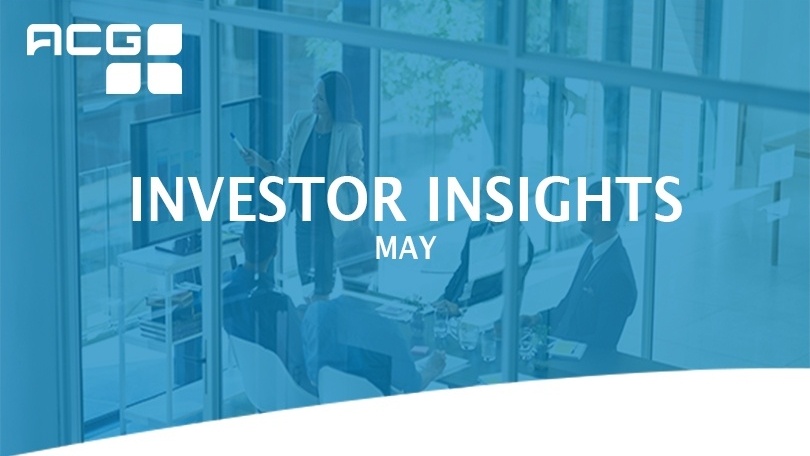
Bobby Moyer is the Chief Investment Officer at ACG. Jimmy Pickert is our Portfolio Manager.
See our recap of April's key statistics and market commentary below.
Noteworthy Numbers
14.98% The S&P 500 Value has outperformed the S&P 500 Growth by 14.98% through the first four months of 2022, a striking reversal from the trend seen in recent years of Growth dominance.
106.1% The spot price of Natural Gas has more than doubled since the beginning of 2022, gaining 106.1% in just four months. The move is part of a broader rally in commodities.
-1.4% U.S. GDP shrunk at an annualized rate 1.4% in the first quarter of 2022. The story told by the underlying components is nuanced; consumer and business spending were strong, while government spending and net exports fell.
Our Take
Stocks and bonds continued to suffer in April, quickly erasing the brief respite enjoyed by investors during March’s rally. The Nasdaq lost 13.2% in April alone and is back in bear market territory, off 24.3% from its all-time high. The S&P 500 lost 8.7% in April (-13% for the year). As has been the case for most of the year, growth stocks have led the way down. The S&P 500 Growth index now has a year-to-date return of -20% compared with its value counterpart, which has only lost 5%. Perhaps the most notable difference between the declines in April vs. earlier in the year is that the mega-cap technology companies are now a much bigger contributor to the fall. Apple, Alphabet, Amazon, Microsoft, Meta, NVIDIA and Tesla made up 27% of the S&P 500’s market capitalization to start the year and they lost 9.7%, 17.9%, 23.8%, 10.0%, 9.8%, 32.0% and 19.2%, respectively in April. We’ve written in the past about the importance of diversifying outside the S&P 500 because of the high concentration in these names and April was a good reminder of why. Bonds have not been the risk reducers they’re intended to be so far this year, and that problem continued to plague investors in April. The main bond index, the Bloomberg Agg, lost 3.8% in April and now has a -9.5% return so far in 2022. This is because the same rising interest rate environment that is causing concerns about growth and stock valuations is also causing a decline in bond prices, which move inversely to interest rate movements. The traditional “60/40 portfolio”—60% in the S&P 500 and 40% in the Bloomberg Agg— has lost 11.6% this year.
The narrative driving the markets was the same in April as it has been all year: Inflation is persistently high (the last reading showed an 8.5% YoY increase in CPI) and the Fed plans to aggressively tighten monetary policy to get prices under control. The Fed hiked its Federal Funds Rate in March and multiple board members, including Chair Powell, have made comments since that time indicating the Fed’s willingness to do what it takes to control inflation. Read: we will hike rates as fast as we can without truly tanking the markets. The market is now flooded with hawkish expectations for monetary policy and interest rates rose over the course of April to reflect it, with the 10-year yield rising from 2.4% on April 1 to 2.9% by April 30.
The markets already appear to be baking in aggressive tightening from the Fed, so the question is: will the Fed continue along the current line of expectations, will it be compelled to tighten policy even more, or will it be given the space to hike rates more slowly? We believe that no one knows this, not even Jerome Powell, because no one knows what inflation will look like over the next 6-12 months.
This is a difficult time for investors. It isn’t necessarily the scale of the decline that makes this time feel different— investors have seen the S&P 500 fall by at least 10% four times in the past decade. Rather, we believe a convening number of factors are contributing to the pessimism. For one, this volatility has been comparatively prolonged. Even though the market hit an all-time high on January 3rd, markets have been choppy since mid-November, when hawkish Fed expectations began to come online, and the Omicron variant created new concerns about the post-pandemic reopening. That is nearly six months of very volatile markets, and that causes investors fatigue. Inflation is also weighing on investor morale. Inflation isn’t some obscure economic indicator, it’s what consumers see when they go to the grocery store and the gas pump. Retirees in particular who are seeing their portfolios go down while their expenses are going up are understandably frustrated. Lastly, the fact that this selloff has touched both stock and bond markets is causing investors more concern. Traditionally, bonds benefit during risk-off periods when capital flows from stocks into safer havens. Conservative investors could take solace in the comparative resiliency of their bond portfolio while more opportunistic investors could sell bonds to buy stocks at a discount. With both stocks and bonds feeling the pain, that traditional dynamic is not at play this time.
What’s the best next move? Stay the course! Look, we realize it gets old to hear us say this. Not only are we repeating ourselves, but it’s times like this when it might feel necessary to take action. The analogies abound: stop the bleeding, stem the tide, steady the ship. If you’re reading this newsletter, chances are you have been very successful in life by taking action, not sitting on the sideline letting events passively occur. We understand this temptation and respect it, but it is not the right answer.
The right answer is to stick with your plan and focus on your long-term goals. Even if you think there’s a good chance the markets continue to suffer (we acknowledge that is possible above), it is still not a good idea to try to time the market by reducing risk in your portfolio. You might be right and avoid further losses, but will you know the right time to get back into the market, too? Keep in mind that the best days in the market tend to cluster around the worst days; jumping out and successfully jumping back in requires either a crystal ball or luck, and it entails the risk of making permanent the losses your portfolio has already experienced.
Humans are short term focused by nature, and today’s fast-moving world has only shortened our attention span. This makes successful investing difficult, because it requires us to look beyond the fear, uncertainty and doubt that might pervade the current markets to the wealth creating power that is generated by capitalism and economic growth over the long run.
Get Monthly Insights Delivered to Your Inbox




